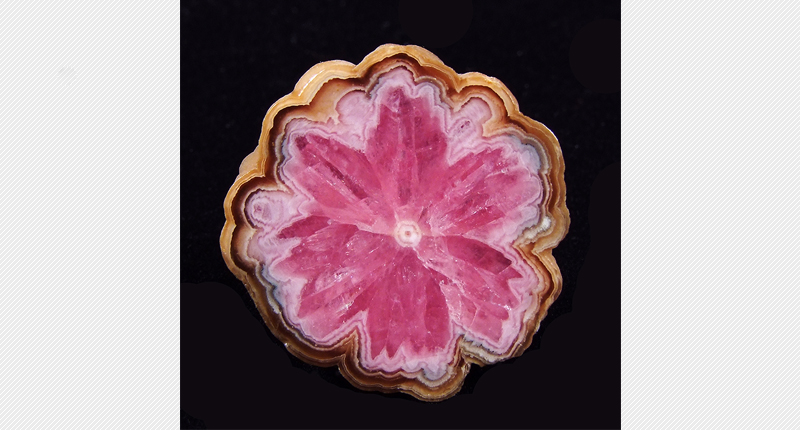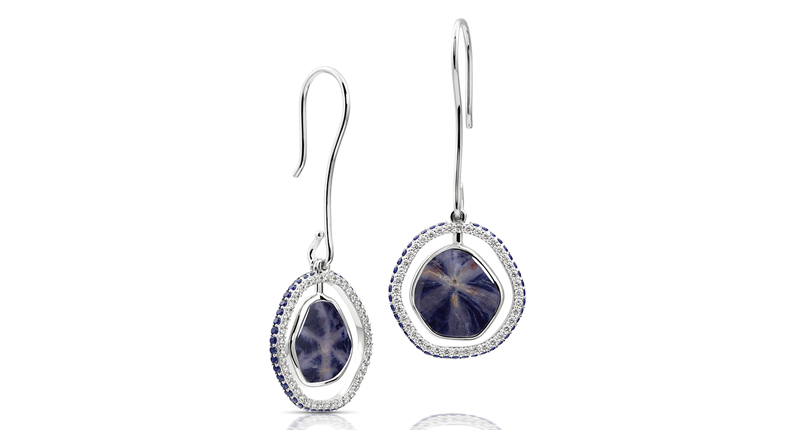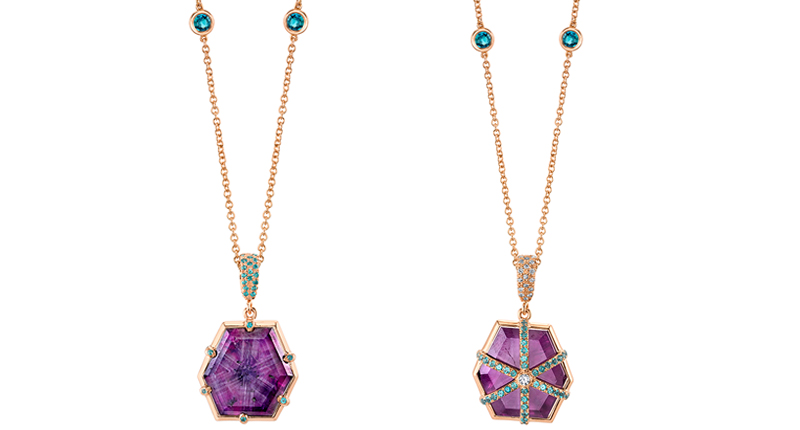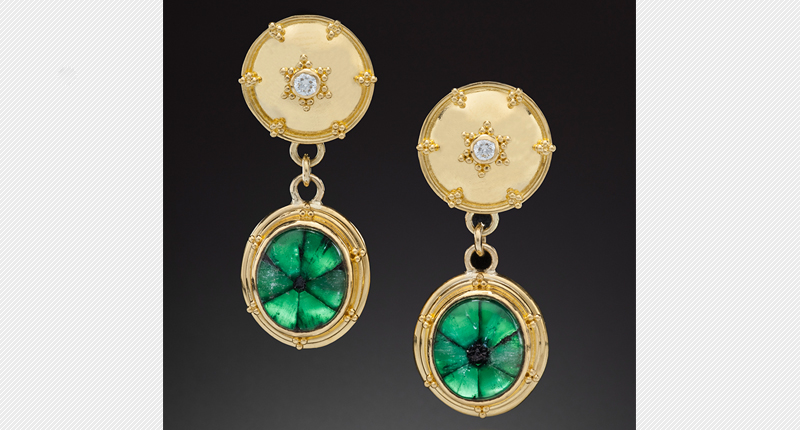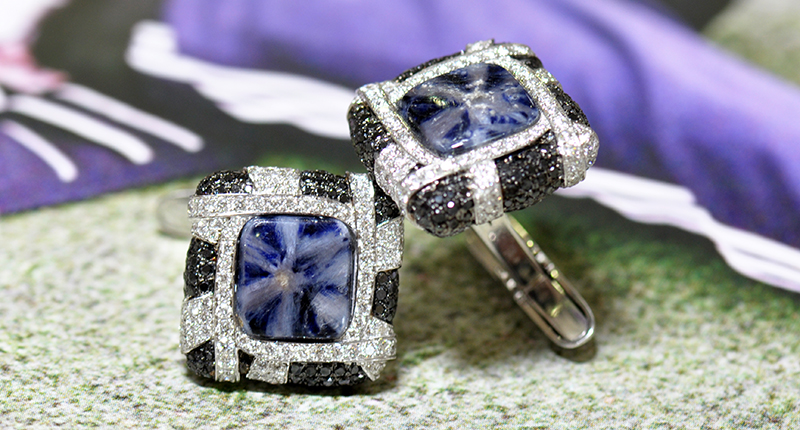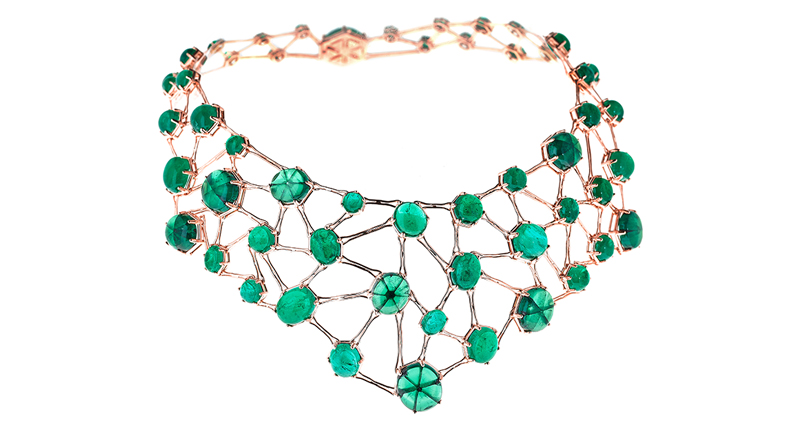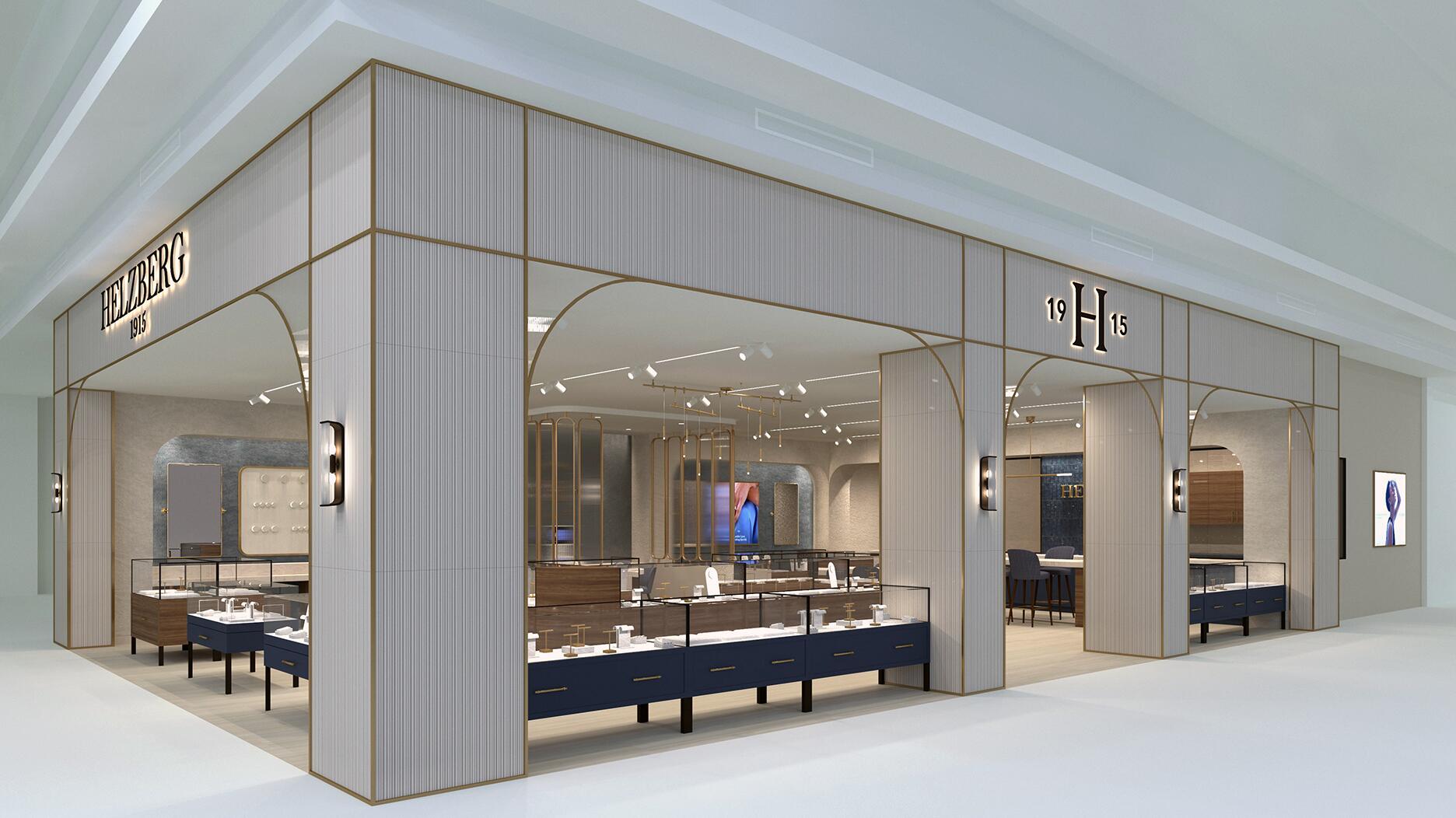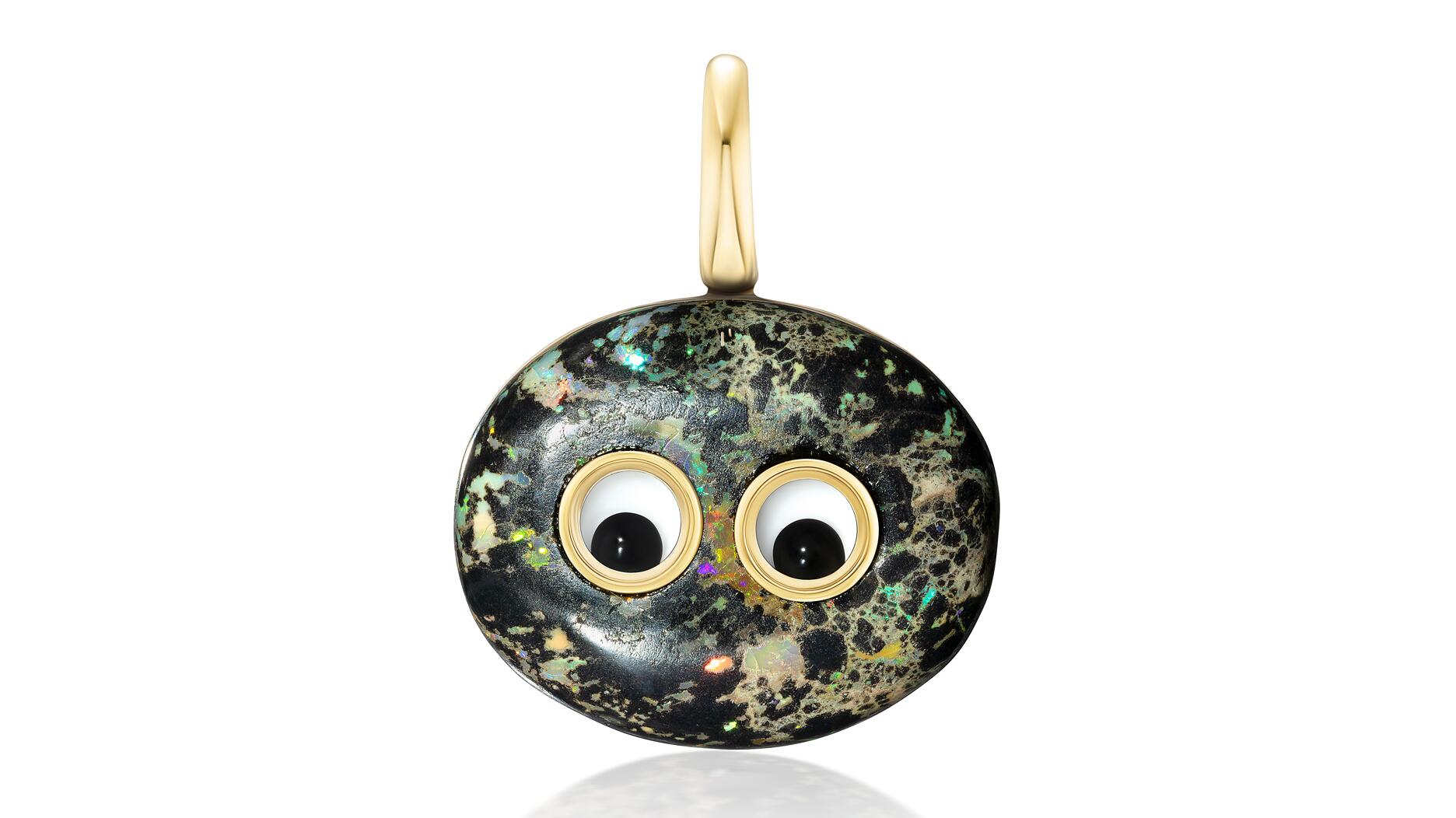In the recent multi-shipment seizure, CBP also found counterfeit Audemars Piguet, Moncler, and Chrome Hearts items.
5 Things to Know About … Trapiche Gems
Here are a handful of interesting facts about the colored stones with a pattern usually resembling a wheel.

Trapiche gemstones are a great example of this. The geometry and symmetry of the stones created by their rayed patterns are truly spectacular and valued for both their beauty and uniqueness.
Trapiche emeralds were first on the scene, at least according to written records, with the name adopted because of their resemblance to “trapiche de caña de azucar,” the Spanish name for the six-spoked cogwheel used in sugar mills.
Beyond the almost-immediate fascination trapiches spark with their beauty and rarity, there’s plenty to know about these stones, starting with these five points below.
1. Trapiche gems have equivalent crystallographic growth patterns separated by boundaries of inclusions.
According to the Gemological Institute of America’s “Gems & Gemology,” these boundaries intersect at a central point or extend from a central core, creating a pattern that, often, resembles a wheel.
Trapiche gems also are characterized by their high symmetry--which appears in a hexagonal manner, for example, for emeralds--and feature inclusions of organic matter.
2. There are a number of gemstones that can be found in trapiche variations.
The spoke patterns that define trapiche gemstones are best known in the popular green beryl, but one can also find trapiche corundum, garnet, tourmaline and chiastolite, though chiastolite only exhibits four arms, InColor said.
3. The history of (finding and studying) trapiche is long.
Or at least for emeralds, that is.
According to Gems & Gemology, Colombian trapiche emeralds were first described by French mineralogist Emile Bertrand in 1879 at a meeting for the Société Géologique de France, though they did not yet have a name.
The first known use of trapiche emeralds in jewelry is in an early-19th century gold ring by an unknown artist that was bequeathed to the Victoria & Albert Museum in London.
Trapiche rubies from Burma, meanwhile, were first documented by the GIA in 1995, according to InColor, but the stones also have been found in Guinea, Kashmir, Pakistan, Nepal, Sierra Leone and Tajikistan.
Trapiche sapphires first appeared on the gem market in early 1996, when samples were offered in Basel by a Berlin gem dealer, and have been found in Australian, Cambodia, China, France, Kenya, Madagascar, Nepal, Sri Lanka, Tanzania and more.
As with any rare gemstone, trapiches are still pretty hard to come by, goldsmith and jeweler Paul Farmer said.
But there may be an opportunity, however big, with pieces or partial trapiche stones, he said, which can make unique pieces such as butterfly wings.
He sees some opportunity in this area as more lower-quality gems come onto the market, noting that they can “make fun, inexpensive pieces,” he said.
Jeffery Bergman of Primagem said emerald trapiche continue to be the most available and in highest demand of all trapiche gems.
Trapiche rubies from Burma, meanwhile, tend to be mostly under 1-carat in size, he added, and rather dark, requiring thin slicing to get the best color and trapiche pattern, which has had the effect of restricting their use in jewelry.
Bergman also said fine trapiche sapphires from Mogok, Burma are still in high demand with very limited supply.
“Most of the material on the market is semi-translucent to opaque, and the occasional gemmy translucent example fetches several thousand dollars per carat,” he said.
He added that Vietnam has been producing some semi-translucent-to-opaque trapiche sapphires ranging in size from 5 to more than 50 carats and reasonably priced at about $50 per carat for finer pieces.
Simon Watt of gemstone dealer Mayer & Watt also said that supply hasn’t changed much, with the fine stones still hard to come by and with the bulk of demand from gem connoisseurs.
What’s more, “There’s never enough (supply) for the demand to be so great,” he said.
In fact, he hasn’t seen a resupply of trapiche sapphires in the past year.
The difference for him, though, is that he’s been marketing the material for years, and it’s paid off with an increased buzz around the gemstones.
5. Prices have increased.
The downside to the buzz he’s created, Watt said, has been a price increase; he said he’s seen prices double in the past five years for fine material.
This is not to mention the rarity of the stones keeping prices high.
Bergman also noted that prices of emerald trapiche have doubled and tripled over the past several years as well-known jewelry designers like Selim Mouzannar, Omi Prive and Erica Courtney have incorporated them into award-winning designs.
Still, Watt is hopeful prices will start leveling out, if nothing else, and notes that when he does get trapiche stones, he has rarely has trouble selling them.
“The end user is really looking for something very unique that blows their mind. Trapiches do just this because you look at them and think, ‘Nature is truly incredible, isn’t it?’”
The Latest

Jewelers of America execs and National Jeweler editors discuss tariffs, the sky-high gold price, and the engagement that broke the internet.

The luxury goods company said founder Ippolita Rostagno will remain at the brand’s helm.

How Jewelers of America’s 20 Under 40 are leading to ensure a brighter future for the jewelry industry.

Laura Burdese, who joined the Italian luxury brand in 2022, will take on the role in July.


Need a gift for the cat lover who has everything? Look no further than our latest Piece of the Week.

It purchased the “Grosse Pièce,” an ultra-complicated Audemars Piguet pocket watch from the ‘20s, for a record-breaking price at Sotheby’s.

Roseco’s 704-page catalog showcases new lab-grown diamonds, findings, tools & more—available in print or interactive digital editions.

The lab-grown diamond grower now offers custom engagement and fashion jewelry through its Kira Custom Lab Jewelry service.

Chandler got his start at Michelson Jewelers and has served as DCA president and CEO since 2001. He will retire at the end of the month.

The boutique is slated to open this week inside Terminal 8, offering pre-owned Rolex watches and more to international travelers.

Sponsored by Digital Monitoring Products

The special-edition egg pendant ingested in a New Zealand jewelry store was recovered after a six-day wait.

Associate Editor Natalie Francisco plays favorites with Piece of the Week, selecting a standout piece of jewelry from each month of 2025.

The “Love and Desire” campaign is inspired by the magic that follows when one’s heart leads the way, said the brand.

Two awardees will receive free tuition for an educational course at the Swiss lab, with flights and lodging included.

Berta de Pablos-Barbier will replace Alexander Lacik at the start of January, two months earlier than expected.

Sotheby’s held its first two jewelry sales at the Breuer building last week, and they totaled nearly $44 million.

Winners will receive free registration and lodging for its fourth annual event in Detroit.

Here are six ideas for making more engaging content for Instagram Reels and TikTok, courtesy of Duvall O’Steen and Jen Cullen Williams.

The honorees include a notable jewelry brand, an industry veteran, and an independent retailer.

Carlos Jose Hernandez and Joshua Zuazo were sentenced to life without the possibility of parole in the 2024 murder of Hussein “Sam” Murray.

Yood will serve alongside Eduard Stefanescu, the sustainability manager for C.Hafner, a precious metals refiner in Germany.

The New Orleans jeweler is also hosting pop-up jewelry boutiques in New York City and Dallas.

Set in a Tiffany & Co. necklace, it sold for $4.2 million, the highest price and price per carat paid for a Paraíba tourmaline at auction.

The jeweler’s “Deep Freeze” display showcases its iconic jewelry designs frozen in a vintage icebox.

Take luxury gifting to new heights this holiday season with the jeweler’s showstopping 12-carat sphene ring.











